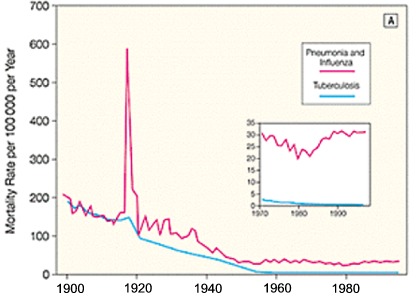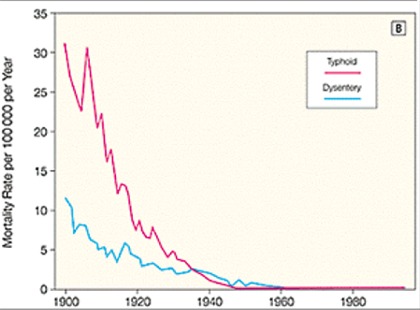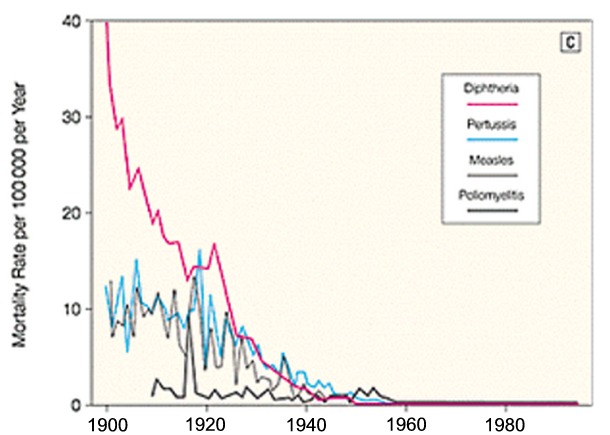Featured
Proof that Childhood Vaccinations Are a Hoax
I have not always been a vaccine skeptic. One day, though, I happened on an article in JAMA and sat bolt upright. It was obvious: The AMA’s own mortality data for the 20th century proves that childhood vaccines are a hoax.
It’s taken as an article of faith that vaccinations have improved our lifespan. Most of us take our children to the doctors for their injections without question. Most think of themselves as bad parents if they don’t. It’s simply one of those things that aren’t questioned, as if it’s obvious. It’s gone so far now that parents have been threatened with prison and their children are coerced into vaccinations.
This article exposes the reality: As documented by the American Medical Association’s own Journal of the American Medical Association (JAMA) in the January 1999 issue, there is no connection between death from infectious diseases and vaccinations. That’s right. None.
First, let’s look at the dates for when vaccinations were first introduced in the United States, according to the Centers for Disease Control:
- Measles (one of the Ms of the MMR vaccination): 1963
- Mumps (the other M of the MMR vaccination): 1967
- Diphtheria (the D of the DPT vaccination): First licensed in 1921, but not widely used until the 1930′s
- Pertussis (whooping cough, the P of the DPT vaccination): First developed in the 1930′s, widely used by the mid-1940′s
- Tetanus (the T of the DPT vaccination): First used as a childhood vaccine in the 1940′s
- Rubella (German measles, the R of the MMR vaccination): 1969
There are several others, of course, but they are either too recent to take into account or not truly associated with childhood illnesses, such as smallpox and polio, which are more appropriately considered epidemic diseases.
The JAMA Study
The number of deaths from nine different infectious diseases, in some cases, groups of diseases, were tallied. They are:
- Pneumonia and influenza
- Tuberculosis
- Diphtheria
- Pertussis
- Measles
- Typhoid fever
- Dysentery
- Syphilis
- AIDS
All but AIDS were chosen because they were the most common cause of death by infectious diseases in the first half of the 20th century, with the exception of polio, for which data are not available for all years covered by the study.
Graphs showing numbers of deaths by age, by infectious disease deaths as a whole, by specific infectious diseases, and by all disease causes are shown plotted by time, from 1900 through 1996.
Results of the JAMA Study
With the exception of 1918, when the great influenza pandemic struck, the rate of deaths from infectious diseases shows a fairly smooth rate of decrease from 1900 through 1980, at which point a slight rate of increase develops. That alone should raise flags. If the vaccines were truly effective, why would the rate of infectious diseases rise?

Figure 1. Crude Infectious Disease Mortality Rate in the United States from 1900 Through 1996 (Graph from JAMA)
Deaths graphed by groups of diseases show some variations. The most significant improvements are in typhus and dysentery. Both of these diseases show almost no deaths after 1960. However, take note of the fact that there is no vaccination for dysentery and most people are not vaccinated for typhus.

Figure 2A. Crude Mortality Rates for Influenza & Pneumonia (Graph from JAMA)
Tuberculosis rates show a curve similar to the overall infectious disease rate. Interestingly, the death rate from pneumonia and influenza from 1970 through 1996 shows a slight increase, in spite of the ongoing vaccinations for influenza and the introduction of pneumonia vaccines in 1977 and 1983.

Figure 2B. Crude Mortality Rates for Typhus & Dysentery (Graph from JAMA
As noted above, deaths from typhus and dysentery plunge to near-zero by 1960—though there is no vaccine for dysentery and passingly few people are vaccinated against typhus.

Figure 2C. Crude Mortality Rates for Diphtheria, Pertussis, Measles, & Polio (Graph from JAMA)
Diphtheria shows its greatest decrease of deaths prior to 1920. There was a spike in diphtheria deaths during the early 1920′s, shortly after the vaccination was introduced, and then the rate of decrease continued as before the vaccination’s introduction. Whooping cough (pertussis) and measles showed the same general trend of decrease during the 20th century.
Finally, take a look at the chart for death rates from all disease causes. From 1900 into the 1920s, the infectious disease rate goes down at an impressive pace. This is a time during which there were no vaccinations against childhood diseases. The decrease in the rate of deaths continues at about the same pace well into the 1950s. Then, it starts to level out, in spite of the fact that the vast majority of children are vaccinated during this time.

Figure 3. Crude Mortality Rates for All Causes (Graph from JAMA)
Now, take a look at the same graph showing the death rates from all diseases. This should make you nervous. The rate of death from noninfectious causes decreases slightly from 1900 through 1920. However, during the 1930s, when vaccinations start to be introduced, the death rate from noninfectious causes started to increase!
What Can Explain the Reduction in Infectious Disease Rates?
Since it’s obvious from the AMA’s own documentation that vaccinations have little or no effect on the outcome of infectious disease deaths, then there must be other issues at play. If one looks at the history of the 20th century in the U.S. then it isn’t too difficult to see what has changed. This was the era of improved overall hygiene and adequate food.
It was when clean and abundant water became the norm. It was when systems to clean wastes from public water supplies became standard. It was when septic and sewer systems to separate people from disease-producing wastes were introduced. It was a time of relative plenty, when people grew larger because of adequate food. In other words, it was a time of relative wealth and public works for good water and sewage treatment.
Adequate food for the masses of people, along with sewage and clean water, are most probably the reasons behind the decrease in infectious diseases, not the medical system’s vaunted vaccinations.
Why Are We Vaccinating Against Childhood Diseases?
This is the multibillion dollar question. Parents usually have their children vaccinated because the idea of not doing it simply doesn’t occur. We have been thoroughly indoctrinated with the concept of “deadly” childhood diseases. Yet, there is no documentation showing that death rates from these diseases have been improved by the vaccinations. As the data that the AMA itself has produced shows, there is every reason to believe that these vaccinations are not effective, that we need to look to other reasons for the decrease in these disease deaths.
Even more significantly, the AMA’s own data show a possible link between an increase in death coinciding with vaccinations. Whether this is a cause-and-effect link is not proven at this time. However, with the AMA’s record of not looking into the effects of vaccinations—of not even requiring that after-effects be reported—it’s clear that the allopathic (standard) medical system is not going to sort this out. That leaves us with no option but to assume the worst—that childhood vaccinations not only do little or no good, they may be doing great harm.
The question, of course, is “Why?” As with any corporate-controlled business—and make no mistake, the medical industry is big business—the answer always goes back to the same thing: money. Filthy lucre. There are millions and billions of dollars, pounds, euros, and other currencies to be made by both the pharmaceutical firms and the doctors themselves.
The Bottom Line
For the medical industry, the bottom line is the bottom line. For each of us and for our children, the bottom line is completely different. It’s the quality of our lives. In the end, the only ones who must live with the results of vaccinations are the children and adults whose bodies have been pierced by the needles injecting them.
Addendum
This article focused on some of the most common childhood vaccines, the ones noted for childhood diseases and also the ones that have existed for the greatest amount of time. However, readers may find the following information about when vaccines have been introduced to be of interest:
- Anthrax: November 20, 2002
- Hepatitis A: HAVRIXR vaccine in 1995, VAQTAR vaccine in 1996
- Hepatitis B: First in 1982; in 1986 a recombinant DNA vaccine issued; in 1989 a second recombinant DNA vaccine issued
- Hib (Haemophilus influenzae type b, not a true influenza virus, but a bacterium): First licensed in 1985, but a “new improved” form licensed in 1987
- HPV (Human papillovirus): June 8, 2006
- Influenza: First introduced in 1945; ongoing updates developed year after year in attempt to keep up with viral changes
- Meningococcus: First in 1974 against one of five major subtypes; others introduced 1981 and 2005 for original subtype and three others; no vaccine exists for fifth subtype (B), which is the cause of 65% of meningitis cases under age 2
- Pneumonia: 1977 for 14 types of bacterial pneumonia; 1983 “improved” vaccine for 23 types of bacteria; a specific vaccine aimed at children under age 2 developed in 2000
- Polio: Jonas Salk killed virus vaccine in 1955; live vaccine in 1961; “enhanced formulation” introduced in 1988
- Rotavirus: February 2006
- Zoster (shingles: stronger version of chicken pox vaccine): May 26, 2006
Source:
- Trends in Infectious Disease Mortality in the United States During the 20th Century, Journal of the American Medical Association, Gregory L. Armstrong, MD; Laura A. Conn, MPH; Robert W. Pinner, MD, doi:10-1001/pubs.JAMA-ISSN-0098-7484-281-1-joc80862.
Tagged 20th century mortality, conventional medicine, infectious disease mortality, jama, jama vaccines, journal of the american medical association, modern medicine, reduction in disease rates, vaccine, vaccine hoax, vaccines, vaccines haven’t reduced disease, vaccines mortality rates
















Pingback: NWO Newz for 12-14-12 | Chapel of Chaos Blog
Pingback: My view of vaccines – Grasscity.com Forums
Pingback: Proof that Childhood Vaccinations Are a Hoax | The Liberty Beacon
Pingback: Vitamin E Is a Potentially Dangerous Vaccine AdjuvantGaia Health
Pingback: A Doctor’s Awakening on Flu Vaccines in Pregnancy | Kinetic Truth